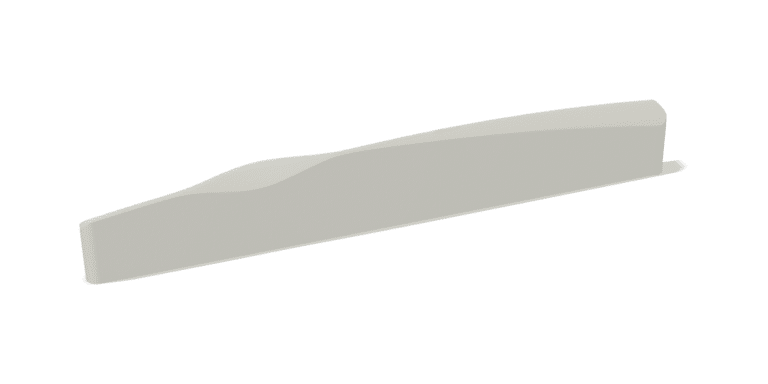Find the Correct Saddle for Your Ibanez® Acoustic Guitar
Are you in need of an Ibanez steel string acoustic guitar saddle? Ibanez uses a seemingly endless number of different saddle compensation patterns, lengths, thicknesses, and top radii, and so you will need to spend a good deal of time finding the correct saddle type for your specific guitar. Ibanez has well over 100 different saddle part numbers.
However, even once you have found the correct saddle type needed, actually getting your hands on a saddle is difficult, too, because Ibanez does not sell parts directly to the public. Ibanez is by far the most difficult major guitar manufacturer to find replacement saddles for, so you will need plenty of patience for this task.
This article provides tips on how to find the correct saddle for your Ibanez steel string acoustic guitar, but we advise that you also measure your guitar’s saddle slot for a proper fit as every guitar is slightly different. If you are not the original owner, at some point someone may have installed a different saddle or have adjusted the saddle slot, producing different specs from the factory’s.
Please note that this article only applies to steel-string acoustic guitars.

Pre-1974 Models
If you have a pre-1974 Ibanez acoustic model, then your guitar will not have a serial number. As such, you can try contacting Ibanez support for information, but there’s a good chance you will need to measure your current saddle and saddle slot as discussed at the end of this article, and get a custom saddle made.
Post-1973 Models
Step One: Determine Guitar Serial Number, Production Month/Year, Series, and Model Number
If your guitar was built after 1973, the first step is to determine your guitar’s serial number, production month and year, series, and model number. Note that having the model number alone is insufficient as Ibanez may have used a different saddle size for different years, and even different months during the same year.
If you are unable to find your serial number, visit this serial number information page for Ibanez.
To determine production month and year, contact Ibanez Support with your serial number.
Step Two: Contact Ibanez Support or Visit Ibanez Parts Information Page
Now that you have the above information you can determine what Ibanez part number your saddle is. To do this, either contact Ibanez Support with your serial number and ask the for the saddle part number, or visit the Ibanez Parts Information Page, which will allow you to search for your guitar series and model, then display various parts used for it. In the upper left hand corner, you will see a number of drop down menus, below which you will see a search box with Model No. listed in light grey letters. Type in your model number into this search box, but before you click the blue Search button, click on the Show archives check box so that a small blue check box appears. If you leave this blank, and your model is discontinued, then the site will not bring it up in the search results. Then click the blue Search button.
You may soon see results for your model, however, please note that not all Ibanez models appear. If not, you will need to contact Ibanez support. If your model is listed, you will likely see multiple results because Ibanez will use different parts for different production years and months. On the far right side, you will see Production Year listed listing month and year ranges. Select the result that your guitar’s production month and year fall within.
You will then see a new page showing a number of parts for your model. Scroll through until you find Saddle. You will commonly see a picture of the saddle part, the part number, and notes. In the Note column, you will sometimes see information that lists the specs and material, something similar to this:
W74 T3 H12 R400, unbleached (natural) oil bone
Below is a description of the above:
W = Length in mm
T = Thickness in mm
H = Maximum Height in mm
R = Top radius in mm
Note that this information lists the size of the saddle you would receive if ordered from an Ibanez dealer, but your current saddle’s actual dimensions will likely differ slightly in length, thickness, and/or height. The factory saddle specs are starting points, not set heights that require no adjustment. Each guitar will have a slightly different neck angle, and so although the factory might set the twelfth fret action at a specified height, technicians can achieve this through a combination of adjusting the neck relief, nut slot height, or saddle height, resulting in different saddle sizes for different guitars, even from the factory.
Additionally, each guitar’s saddle will have different heights for the bass and treble sides. For many Ibanez saddles this is often about a 1.2 to 1.6 mm height difference, but can vary for each guitar. Please see our guide on Bass to Treble Edge Height Difference for more information.
Step Three: Find an Ibanez Dealer or Have a Saddle Made
Now that you know the Ibanez saddle part number, you will need to find an Ibanez dealer to purchase from because Ibanez does not sell parts directly to customers. Unfortunately, though, few Ibanez vendors carry acoustic saddles. Try doing a Google, Ebay, or Reverb.com search for the specific Ibanez part number and you might have some luck. Or try contacting an Ibanez dealer and asking whether they can order the part for you.
Note that the saddle you need may no longer be in production. As such, you will need to get a custom saddle made, or find an aftermarket saddle. Unfortunately, aftermarket saddles specifically and properly designed on Ibanez factory saddle types are rare. You might find some companies advertising saddles claiming that are made for Ibanez, but before purchasing one of these, check the specs carefully against the saddle specs you need.
See our Notes on Ibanez Saddles for information on some specific saddle parts.
Which Saddle Does Your Ibanez Need?
Still wondering which saddle size your Ibanez steel-string acoustic requires? Please contact us with all of the below information.
- Guitar Serial Number, Production Month/Year, Series, Model
- Current Saddle Length, Maximum Height, Thickness – Must be measured with a caliper
- Bass to Treble Edge Height Difference
- Bridge Saddle Slot Length, Thickness (if different from saddle specs) – Must be meausured with a caliper
- String Spacing at the Bridge
- Current Saddle Compensation Pattern (Please send a picture if you are not sure which type you have)
We will respond within 48 hours.
